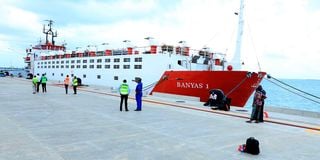Premium
19 vessels in two years: Shame of underutilised Lamu Port

Mv Banyas 1 Lome Vessel which docked at the Port of Lamu Berth Number 1 in this photo taken on October 15, 2022.
On May 20, 2021, Kenya operationalised the second commercial port in Lamu with fanfare.
It was expected to be a major transhipment facility serving different countries in East and Horn of Africa.
But almost two years later, the facility has failed to fully take off, handling 19 ships only — the same number of ships that dock at the port of Mombasa in a week.
During the same period, less than 2,000 twenty feet equivalent units (TEUs) containers and about 20,000 animals were handled at the facility, with different countries still depending on Salalah port in Oman as their transhipment port.
But port users say they will only use the facility if their recommendations are met.
“We gave our recommendations as the private sector. Lamu Port can only be viable if infrastructure and security is improved,” said Kenya International and Warehousing Association National Chairman Roy Mwanthi.
Lamu port was expected to make the stalled Lamu-Southern Sudan-Ethiopia Transport Corridor (Lapsset) viable.
In 2014, the Kenya Ports Authority (KPA) agreed on a deal with China Communications Construction Company for the construction of three Lamu Port berths that form part of the long-envisioned Sh2.4 trillion Lamu Port and Lapsset, also known as the Lamu Corridor.
Largest port facility
If completed, Lamu Port will have 32 berths and replace Mombasa’s Kilindini Harbour as Kenya’s largest port facility.
However, the Lapsset project has been stalled due to regional insecurity concerns on the border with Somalia, political instability in Kenya, and a lack of other investments.
Owing to its depth, the Lamu port can accommodate big container ships and small ships picking cargo from Lamu for onward transhipment to other ports in the world, including feeding the Mombasa port.
Salalah is the biggest port in the Arabian Peninsula and most ships in Eastern Africa use this it for most transshipments, both in and outbound.
This potentially puts Salalah port in direct competition with Lamu. However, Kenya must take a bolder step to market the port so that scheduled cargo is directed to Lamu.
New KPA Managing Director William Kipkemboi Ruto has made the Lamu port his priority to ensure it attracts more volumes in the near future.
The second and bigger plan by KPA is to ensure cargo destined for the Southern part of Ethiopia and South Sudan use the port, but this will only be viable once the roads and rail connecting the two countries are developed.
Flagship project
Lamu is one of the flagship infrastructure projects under Kenya’s Vision 2030 and is being promoted as a transport corridor linking a new and modern Port of Lamu with Garissa, Isiolo, Maralal, Lodwar and Lokichogio.
It will also be branching at Isiolo to Moyale at the border with Ethiopia and proceeding to the border with South Sudan.
The Kenya government has been planning developments along the Lamu corridor although the impact of these investments has been small and highly localised.
But KPA says 19 ships which have so far docked at the port, with the most recent one having done so last weekend, is an improvement considering challenges in the area.
Speaking in Lamu this week, KPA Board chairperson Benjamin Tayari said the authority is working to ensure full commercialisation of the port.
Mr Tayari said plans are underway to acquire modern ship and cargo handling equipment to ease the loading and unloading of cargo from vessels.
He is confident that Lamu has the ability to emerge as the most competitive port in the region.
“As we advance plans to acquire modern ship and cargo handling equipment, I can assure you that Lamu will finally emerge as the most competitive port of call in the region and plays a pivotal role in the community. As you’re aware, the port received its 19th vessel over the weekend,” said Mr Tayari.
Lamu Port Manager Vincent Sidai called for a concerted effort from all stakeholders to ensure the success of the port’s operations. “With unity of purpose, nothing is difficult. Let’s have the zeal and determination to ensure the Lamu Port is successful,” said Mr Sidai.
The Sh310 billion Lamu Port was operationalised by retired President Uhuru Kenyatta on May 20, 2021, the same day he commissioned the Sh10.8 billion Lamu-Witu-Garsen road.
It is the same day that the first ship, MV CAP Carmel, with general cargo from the Port of Dar es Salaam in Tanzania, made its maiden docking at the Lamu Port while on its way to Salalah in Oman.
Since then, 18 other ships have docked at the facility situated in Kililana, Lamu West.
The most recent ship that docked at the port last weekend is container carrier MV Boston Trader, which has an overall length of 146.47 metres and sails under the flag of Liberia.
The vessel was laden with 296 Zanzibar-bound full containers for discharge.
KPA is optimistic more vessels will be docking at the port due to recent incentives to encourage more shipping lines to use the Mombasa and Lamu ports as the gateway to the wider eastern Africa region.
The incentives include exempting fuel supplied to shipping lines from import and excise duty, value-added tax, railway development levy and import declaration fees.






